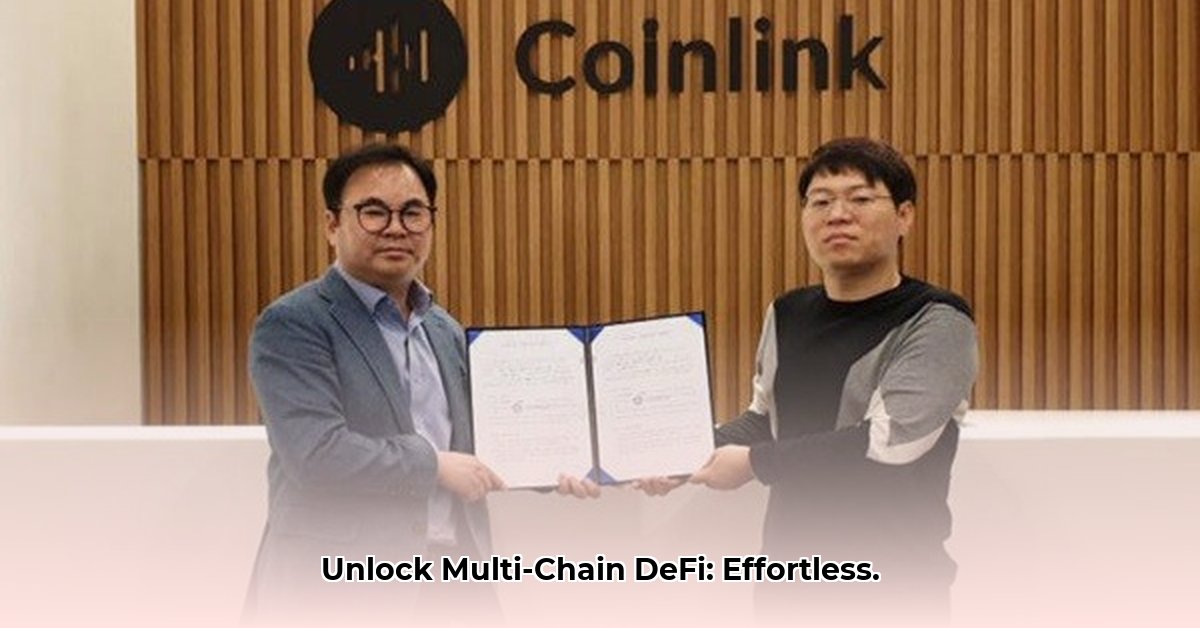
Coinlink is streamlining access to the complex world of decentralized finance (DeFi). DeFi, essentially a global network of financial applications spread across numerous blockchains (digital ledgers), presents significant usability challenges. Coinlink acts as a bridge, simplifying access to various DeFi services without requiring users to be blockchain experts. This article analyzes Coinlink's multi-chain approach and considers its potential synergy with JINGDONG's HKD-pegged stablecoin.
Coinlink: A Multi-Chain DeFi Gateway
Coinlink's core innovation lies in its multi-chain functionality. Unlike platforms confined to a single blockchain, Coinlink seamlessly connects to multiple networks, granting access to a broader range of DeFi applications. This capability is achieved through a combination of smart contracts (self-executing agreements on a blockchain) and APIs (application programming interfaces that facilitate communication between software systems). This architecture allows Coinlink to act as a universal translator for DeFi interactions, ensuring requests are routed and processed accurately across diverse blockchain environments.
Coinlink and JINGDONG Stablecoin: Exploring Synergies
JINGDONG's Hong Kong dollar (HKD)-pegged stablecoin, when integrated with Coinlink, presents a potential pathway to easier HKD transactions within the DeFi ecosystem. This pairing could enhance stability and accessibility for users interacting with HKD-denominated assets. However, several critical factors require careful consideration. The specific blockchain technology used by JINGDONG's stablecoin influences its scalability and potential transaction costs. Further investigation into these factors is crucial for a comprehensive assessment of this pairing's viability.
Comparative Analysis: Coinlink vs. JINGDONG Stablecoin
The following table summarizes the key features, benefits, and potential drawbacks of both Coinlink and JINGDONG's stablecoin:
| Feature | JINGDONG Stablecoin | Coinlink |
|---|---|---|
| Primary Function | HKD-pegged stablecoin for DeFi transactions | Multi-chain access point to DeFi applications |
| Key Benefit | Facilitates reliable HKD transactions in DeFi | Simplified access to diverse DeFi platforms |
| Potential Drawback | Scalability limitations; regulatory uncertainty | Security risks; integration complexity; potential for slow processing speeds |
| Synergistic Potential | Increased usability within the DeFi ecosystem | Expands the reach and utility of the JINGDONG stablecoin |
Navigating the Regulatory Landscape: A Critical Factor
Both JINGDONG's stablecoin and Coinlink operate within a rapidly evolving regulatory environment. The lack of comprehensive public information regarding their compliance strategies poses a concern. Clear regulatory frameworks and proactive engagement with authorities are essential for sustained growth and investor confidence. Both projects must actively demonstrate compliance and work with regulatory bodies to secure a stable operating environment.
Mitigating Security Risks in HKD-Pegged Stablecoins: A Multi-faceted Approach
The security of HKD-pegged stablecoins and their integration with platforms like Coinlink hinges on several critical factors. Addressing these risks requires a comprehensive approach:
Enhanced Transparency and Audits: Regular, independent audits of reserves and transparent disclosure of collateralization mechanisms bolster investor confidence. Open-source smart contracts further enhance transparency and accountability.
Robust Risk Management: Implementation of rigorous risk management frameworks, including stress tests and real-time monitoring of on-chain activity, is crucial for detecting and mitigating potential threats.
Regulatory Compliance and Engagement: Proactive engagement with regulatory bodies and strict adherence to AML/KYC (Anti-Money Laundering/Know Your Customer) regulations are essential for long-term sustainability.
Technological Advancements: Employing highly scalable and secure blockchain technologies, coupled with continuous improvements in smart contract security (including code audits and bug bounty programs), are crucial for stability.
Liquidity Management: Ensuring sufficient liquidity through strategic partnerships and adequate reserves is essential to meet redemption demands without compromising the stablecoin's peg.
Key Takeaway: The effective management of these risks is paramount for the success of HKD-pegged stablecoins and their seamless integration within the DeFi ecosystem.
The Future of Coinlink and JINGDONG's Stablecoin: Challenges and Opportunities
The future success of both Coinlink and JINGDONG's stablecoin depends on addressing challenges related to user experience, security, and regulatory compliance. Strategic partnerships, increased transparency, and technological advancements (including improvements in scalability) are likely to play significant roles in shaping their trajectory. The evolving regulatory landscape and potential conflicts, between innovation and regulatory compliance, will require constant adaptation and vigilance. While risks exist, the potential for increased access and broader usability within the DeFi space remains significant.